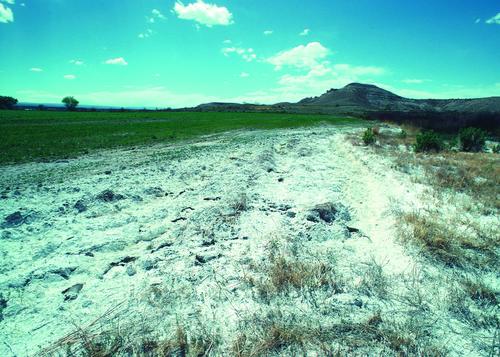Salinization
Two main chemical processes contribute to salinization. One is salinization itself, which is the accumulation of large amounts of soluble salts in the soil, usually chlorides, carbonates and sulfates of sodium, magnesium and calcium. The other is sodicity, a term used for the accumulation of large amounts (more than 10 per cent) of sodium in the soil. Although seen as separate processes by some experts, here both of these processes are considered as salinization, a major degrading soil process in arid and semi-arid climates.
Salinization is one of the most widespread soil degradation processes on the earth and has been a feature of soils for thousands of years. It is largely, though not solely, connected with areas in which the ratio of precipitation to evapotranspiration is less than 0.75. This climatic regime with a very low rainfall and high evaporation means that there is little or no washing out of salts and they can accumulate in the upper parts of the soil coinciding with the root zone. Under evaporative conditions, salts can also be deposited on the soil’s surface. Human induced salinization has been affecting soils for centuries. In the last few decades, there has been a marked increase in the areal extent of salinization and many countries now suffer from this problem. It is thought to affect more than one billion hectares of land. It occurs mainly in the arid and semi-arid regions of Asia, Australia, South America and the United States of America. In Europe it mainly affects the Iberian Peninsula (Spain and Portugal), the Ukraine and the Carpathian and Caspian regions.
There are three main sources of salinization. Some is natural, and has developed over millions of years and is associated with a combination of climate and parent rocks from which and under which the saline soils have formed. Hydrological conditions and landscape position are also important and many of these soils have developed in inland evaporative basins. Low-lying basins in which feed waters from the surrounding higher areas are particularly vulnerable to salinization. Salinized soils also occur in coastal zones where they have formed under marine incursions. In addition to other consequences events such as tsunamis transfer large amounts of saline water inland where it will damage the coastal soils almost irreparably. Human-induced salt accumulation is, however, the main reason for the recent increase in salinization. Irrigation has become a widely used practice for providing water to crops in arid areas and many of these waters are laden with salts entering the soil. (Soil-Net 2016b)
